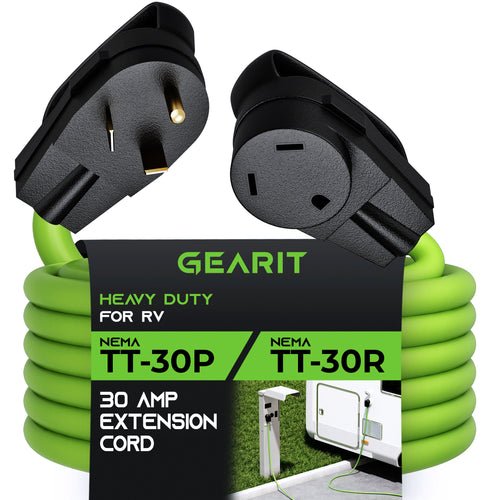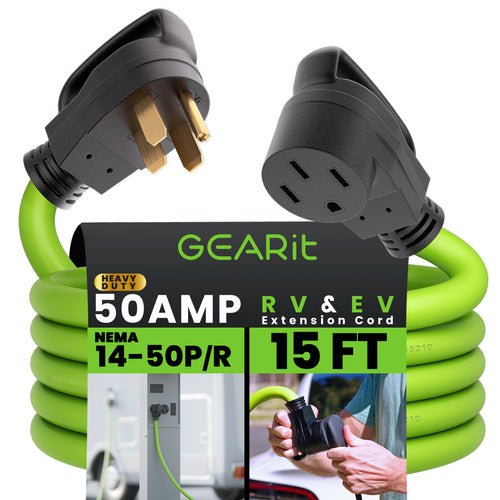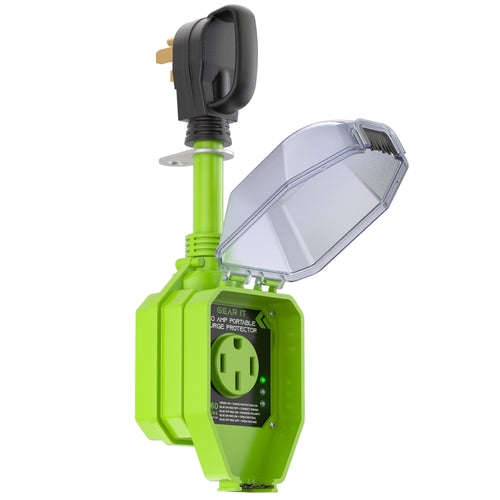RV plugs come in various types, such as 30-amp and 50-amp connectors, each suited for different power needs. Choosing the right plug and cable ensures a safe and reliable connection for your RV, preventing electrical issues on your travels.
Power your RV with GearIT’s premium RV extension cords and surge protectors:
Stay powered and protected on the road—shop GearIT today for reliable RV cables and accessories! ⚡🚐
Recreational vehicle (RV) plugs are distinctly different from standard household plugs. Unlike common household appliances such as microwaves or irons, RVs require plugs that can handle significantly higher electrical loads. Typically, RVs are rated for either 30 amps or 50 amps, each necessitating a specialized plug to accommodate these higher power demands.
Types of RV Plugs
Using the incorrect plug for your RV can lead to electrical system failure due to receiving an inappropriate amount of electrical current. Fortunately, safety mechanisms such as circuit breakers and surge protectors are designed to trip or activate in these situations to prevent damage. To ensure compatibility with various RV amp ratings, most campgrounds offer specialized hookups capable of handling both 30-amp and 50-amp connections.
30 Amp
It’s easy to spot 30-amp RV plugs. These are much larger than a 15-amp plug, which is the plug usually associated with extension cords or oversized devices that run on electricity. There are three prongs to the 30-amp, with two slanted prongs on the top and one round prong beneath these. You will find this type of plug on a midsized RV or units with just one air conditioning unit.
50 Amp
At first glance, the 50-amp plug looks similar to the 30-amp. They are about the same size, but there are different prongs. With the 50-amp, you have four prongs. There are three flat prongs on the bottom and one round prong at the top. Large RVs and motorhomes use more electricity, requiring a higher-rated plug.

15/20 Amp
There are RV plugs rated as a 15/20 amp, but these are usually on small teardrop or pop-up camping units. These are much smaller than the others and look like a standard three-prong household plug. There are two flat prongs and one U-shaped prong to ground the plug. You will find these outlet options on a large RV, but this plug wouldn’t be the main power source.

Power Adapters
Even though the plugs aren’t the same, it’s possible to connect your 30-amp plug to a 50-amp hookup. You would need the right adapter, but it doesn’t change how much power the unit can draw. If your RV requires 50 amps to run all the lights, the electronics and two air conditioning units, but you used an adapter to plug into a 30-amp hookup, you can only draw 30 amps before you trip the breaker. You may be limited in what can run when converting down in amps.
Surge Protectors
You absolutely need a surge protector for your RV, regardless of what plug you use. Your RV plug connects to the device, which then makes the connection to the power source. The protection will prevent surges in the event of lightning or a faulty power source. A surge could damage your RV’s electrical system or any electronics connected inside the RV.
Quality Plugs & Adapters
GearIT carries a wide selection of durable RV plugs in a number of different lengths. In addition to these weather-resistant plugs, you will find a selection of adapters to meet all your RVing needs. Order your plug today.



























































